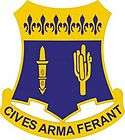109th Infantry Regiment (United States)
| 109th Infantry Regiment | |
|---|---|
|
Coat of arms | |
| Active | 1877 |
| Country |
|
| Allegiance | Pennsylvania |
| Branch | Pennsylvania Army National Guard |
| Type | Infantry |
| Nickname(s) | Thirteenth Pennsylvania (special designation) [1] |
| Motto(s) | "Cives Arma Ferant" (Let the Citizens Bear Arms) |
| Engagements |
World War I World War II Iraqi Freedom |
| Decorations |
Presidential Unit Citation (Army) French Croix de Guerre with Palm, World War II Luxembourg Croix de Guerre[2] |
| Commanders | |
| Notable commanders | James Earl Rudder |
| Insignia | |
| Distinctive unit insignia |
 |
| U.S. Infantry Regiments | |
|---|---|
| Previous | Next |
| 108th Infantry Regiment | 110th Infantry Regiment |
The 109th Infantry Regiment ("Thirteenth Pennsylvania")[1] is an infantry regiment of the United States Army. Its legacy unit, 1st Battalion, 109th Infantry, is part of the 55th Heavy Brigade Combat Team, a unit of the 28th Infantry Division.
History
Assigned to the 28th Infantry Division (Pennsylvania Army National Guard). Currently, the 1st Battalion/109th Infantry is a component unit of the 55th Heavy Brigade Combat Team of the 28th Infantry Division.
In the First World War, the regiment arrived in France in May, 1918, and was engaged in combat during the Second Battle of the Marne (July 14-18, 1918) in the vicinity of Bois le Rois commune, in the Seine et Marne department, as well as during the Meuse-Argonne offensive, the principal engagement of the American Expeditionary Forces during the First World War, from September until the end of the war on November 11, 1918.
During its participation in the European Theater of Operations in the Second World War, the 109th Regiment served across France and through the Hurtgen Forest of Germany; elements of the Regiment led the Division into the Rhineland to become the first troops to invade German soil since Napoleon. The 109th Infantry won battle honors at Normandy, Northern France, Ardennes-Alsace, the Rhineland and Central Europe and they were honored with the Luxemburg Croix de Guerre and the French Croix de Guerre for action at Colmar "Colmar Pocket" . Eddie Slovik, a member of this regiment was the only American soldier executed for desertion in the 20th century.
Distinctive unit insignia
- Description
A Gold color metal and enamel device 1 1/8 inches (2.86 cm) in height overall consisting of a shield blazoned: Azure in fess, a sheathed Roman sword, point to base, and a giant cactus Or; on a chief of the last six fleurs-de-lis of the field. Attached below the shield a Gold scroll inscribed "CIVES ARMA FERANT" in Blue letters.
- Symbolism
The shield is blue for Infantry. The sheathed Roman sword, taken from the Spanish War Service Medal, indicates the service during the Spanish–American War, the cactus denotes the service on the Mexican Border and the chief with the six fleurs-de-lis symbolizes the six battle honors during World War I.
- Background
The distinctive unit insignia was approved on 11 June 1929. It was amended to correct the description on 6 July 1929.
Coat of arms
Blazon
- Shield
Azure, in fess a sheathed Roman sword, point to base, and a giant cactus Or; on a chief of the last six fleurs-de-lis of the field.
- Crest
That for the regiments and separate battalions of the Pennsylvania Army National Guard: On a wreath of the colors (Or and Azure) a lion rampant guardant Proper holding in dexter paw a naked scimitar Argent, hilted Or, and in sinister an escutcheon Argent on a fess Sable three plates. Motto CIVES ARMA FERANT (Let the Citizens Bear Arms).
Symbolism
- Shield
The shield is blue for Infantry. The sheathed Roman sword, taken from the Spanish War Service Medal, indicates the service during the Spanish–American War, the cactus denotes the service on the Mexican Border and the chief with the six fleurs-de-lis symbolizes the six battle honors during World War I.
- Crest
The crest is that of the Pennsylvania Army National Guard.
Background
The coat of arms was approved on 2 July 1929.
Medal of Honor
One soldier, Technical Sergeant Francis J. Clark of Company K, earned the Medal of Honor while serving with the 109th Infantry on 12 September 1944 during the Siegfried Line Campaign.
See also
- Coats of arms of U.S. Infantry Regiments
References
-
 This article incorporates public domain material from the United States Army Institute of Heraldry document "109th Infantry" (retrieved on 2012-02-24).
This article incorporates public domain material from the United States Army Institute of Heraldry document "109th Infantry" (retrieved on 2012-02-24). -
 This article incorporates public domain material from websites or documents of the United States Army Center of Military History.
This article incorporates public domain material from websites or documents of the United States Army Center of Military History.
- 1 2 "Special Designation Listing". United States Army Center of Military History. 21 April 2010. Archived from the original on 9 June 2010. Retrieved 14 July 2010.
- ↑ 109th Infantry Regiment Lineage and Honors, US Army Center of Military History (CMH), 6 February 2013. Retrieved 2 July 2014.
External links
- http://www.hampton.lib.nh.us/hampton/history/military/28thDivision109thRegt/109thhistory.htm
- http://www.hmisite.com/history_of_109th.htm
- http://www.globalsecurity.org/military/agency/army/1-109in.htm
